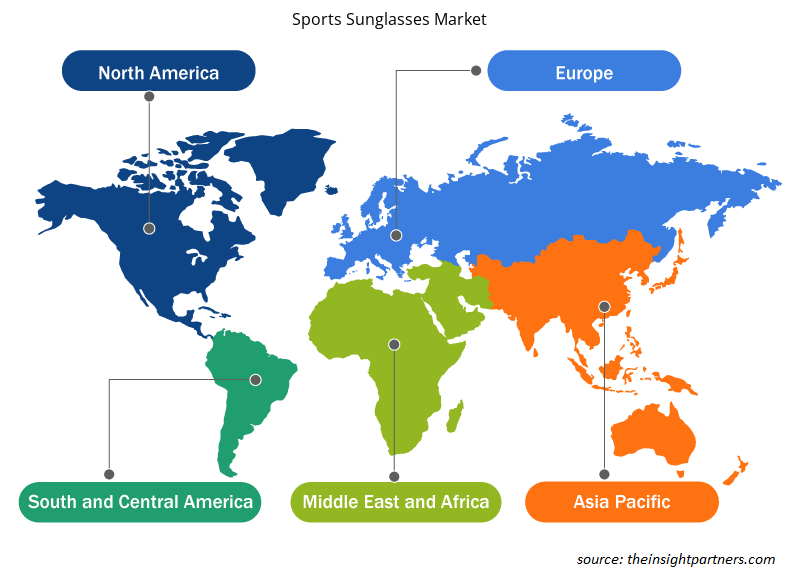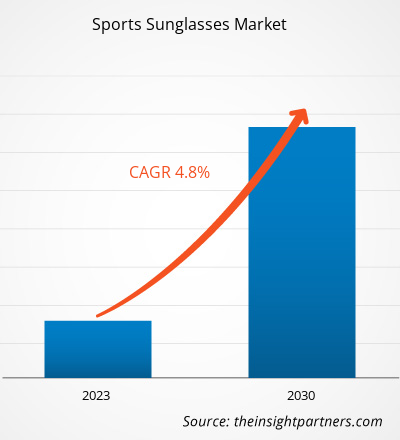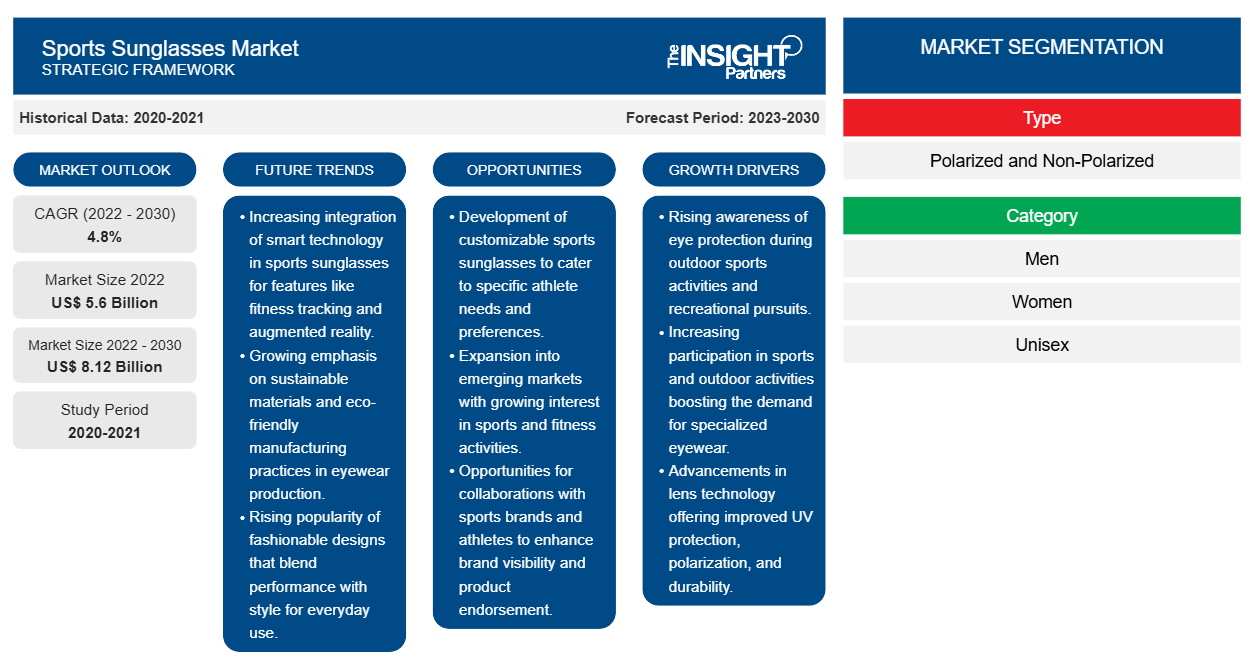[調査レポート] スポーツサングラスの市場規模は、2022年の55億9,708万米ドルから2030年には81億1,506万米ドルに成長すると予測されており、2022年から2030年にかけて市場は4.8%のCAGRを記録すると予想されています。
市場洞察とアナリストの見解:
スポーツサングラスは、屋外スポーツをする際に視認性と快適性を向上させるために使用される保護眼鏡です。強い日光への露出を最小限に抑え、目へのダメージを防ぎます。レンズはプラスチックまたはガラス素材を使用して製造されています。紫外線(UV)ブロッカーと耐衝撃フィルムでコーティングされており、まぶしさを軽減し、コントラストを向上させて、フィールドでの視認性を向上させます。サングラスには、偏光タイプと非偏光タイプがあり、色付きレンズと色なしレンズがあり、日常使いに適しています。スポーツサングラスは、サイクリング、水泳、マウンテンバイク、サイクリング、野球、クリケット、その他の屋外活動などのスポーツ活動を行う際に一般的に使用されます。これらの要因がスポーツサングラス市場を牽引しています。
成長の原動力と課題:
多くの人がさまざまなスポーツやアウトドア活動に従事しています。スポーツ愛好家は、ほこり、風、破片などの潜在的なリスクから目を保護することの重要性を理解しています。そのため、スポーツ活動中に最適な保護を提供し、パフォーマンスを向上させるように設計されたスポーツサングラスを使用しています。スポーツ&フィットネス業界協会(SFIA)によると、米国の人口の76%以上(つまり、2億3,690万人)が2022年に少なくとも1つのアクティビティに参加しており、総参加率は2017年から9.2%上昇し、2021年から1.9%増加しています。また、ユーロスタットによると、2019年には、ヨーロッパの人口の約44%が少なくとも週に1回は何らかの身体活動を行っていました。さらに、多様化するスポーツやアウトドア活動により、特定のニーズを満たすようにカスタマイズされたスポーツサングラスの需要が生まれています。
さらに、より健康的で活動的なライフスタイルへの文化的変化により、スポーツやアウトドア活動を行う人の数が増加しました。この変化は競技選手に限定されず、レクリエーション スポーツ、ランニング、ハイキング、その他のレジャー活動に参加する人も含まれます。スポーツ サングラスはファッション ステートメントとなり、この活動的なライフスタイルの象徴となっています。
特に屋外で紫外線 (UV) に長時間さらされると、白内障、光角膜炎、翼状片など、さまざまな目の状態や疾患を引き起こす可能性があります。これらの状態は不快感、視力障害、場合によっては永久的な目の損傷を引き起こす可能性があります。スポーツやその他の屋外活動に従事する場合、最高のパフォーマンスを発揮するには、クリアで障害のない視力が必要です。紫外線に過度にさらされると、目を細めたり、不快感、視覚の明瞭性の低下を引き起こす可能性があります。UV 保護機能付きのスポーツ サングラスは、アスリートが活動中に最適な視力と集中力を維持し、全体的なパフォーマンスを向上させることを保証します。
要件に合わせてレポートをカスタマイズする
このレポートの一部、国レベルの分析、Excelデータパックなど、あらゆるレポートを無料でカスタマイズできます。また、スタートアップや大学向けのお得なオファーや割引もご利用いただけます。
- このレポートの主要な市場動向を入手してください。この無料サンプルには、市場動向から見積もりや予測に至るまでのデータ分析が含まれます。
レポートのセグメンテーションと範囲:
「世界のスポーツサングラス市場」は、タイプ、カテゴリ、流通チャネル、および地域に基づいてセグメント化されています。タイプに基づいて、スポーツサングラス市場は偏光と非偏光に分かれています。カテゴリに関しては、市場は男性、女性、ユニセックス、および子供に分割されています。流通チャネルに基づいて、スポーツサングラス市場はスーパーマーケットとハイパーマーケット、専門店、オンライン小売、その他に分割されています。地域別には、市場は北米(米国、カナダ、メキシコ)、ヨーロッパ(ドイツ、フランス、イタリア、英国、ロシア、その他のヨーロッパ)、アジア太平洋(オーストラリア、中国、日本、インド、韓国、その他のアジア太平洋)、中東およびアフリカ(南アフリカ、サウジアラビア、UAE、その他の中東およびアフリカ)、南米および中米(ブラジル、アルゼンチン、その他の南米および中米)に分割されています。
セグメント分析:
タイプに基づいて、スポーツサングラス市場は偏光と非偏光に分かれています。非偏光セグメントは2022年に市場の大きなシェアを占めました。非偏光スポーツサングラスの需要は、パフォーマンス中に目を保護するとともに全体的な健康を確保する必要のあるアスリートやフィットネス愛好家の間で急増しています。レンズ技術の進歩により、より軽量で快適で耐久性のある非偏光スポーツサングラスが導入され、より幅広い視聴者にアピールしています。さらに、ファッション業界がスポーツアクセサリーに影響を与えたことで、アイウェアの選択においてパフォーマンスと美観を求める人々の間でスタイリッシュで機能的な非偏光スポーツサングラスの人気が高まっています。
地域分析:
地理に基づいて、スポーツサングラス市場は、北米、ヨーロッパ、アジア太平洋、南米および中米、中東およびアフリカの5つの主要地域に分割されています。北米は世界のスポーツサングラス市場を支配しました。この地域の市場は、2022年に17億9,100万米ドルと評価されました。ヨーロッパは市場の2番目に大きな貢献者であり、世界市場の約25%を占めています。中東およびアフリカは、予測期間中にスポーツサングラス市場で6.5%のCAGRを記録すると予想されています。北米では、スポーツへの参加の増加と目の保護に関する意識の高まりにより、市場が大幅に成長すると予想されています。スポーツ&フィットネス産業協会(SFIA)によると、2022年には全アメリカ人の76%以上、つまり2億3,690万人が少なくとも1つのスポーツ活動に参加しました。したがって、さまざまなスポーツカテゴリーへの北米人の参加の拡大は、地域全体でスポーツサングラスの需要をさらに高めます。さらに、中東およびアフリカの市場は、スポーツ分野への政府の大規模な投資により、顕著な成長を遂げています。たとえば、サウジアラビアやアラブ首長国連邦を含む湾岸協力会議(GCC)加盟国は、2022年にスポーツ開発に650億米ドル以上を費やし、収益成長の可能性が最も高いとされるサッカーとeスポーツに主に焦点を当てています。個人やフィットネス愛好家の間でスポーツと体力の重要性についての意識が高まっていることから、中東およびアフリカでのスポーツサングラスの需要が高まっています。
業界の発展と将来の機会:
スポーツサングラス市場で活動する主要企業が行っているさまざまな取り組みを以下に示します。
- 2022年12月、英国のアイウェアブランドSunGodは、ロンドンを拠点とするクリテリウムサイクリングチームとコラボレーションし、Vulcanzサングラス「Tekkerz Vulcanz」を発売しました。このモデルには、フォトクロミックレンズ、紫外線記憶ポリマーフレーム、親水性イヤーソックスとノーズパッドが含まれています。
スポーツサングラス市場の地域別分析
予測期間を通じてスポーツサングラス市場に影響を与える地域的な傾向と要因は、Insight Partners のアナリストによって徹底的に説明されています。このセクションでは、北米、ヨーロッパ、アジア太平洋、中東、アフリカ、南米、中米にわたるスポーツサングラス市場のセグメントと地理についても説明します。

- スポーツサングラス市場の地域別データを入手
スポーツサングラス市場レポートの範囲
| レポート属性 | 詳細 |
|---|---|
| 2022年の市場規模 | 56億米ドル |
| 2030年までの市場規模 | 81.2億米ドル |
| 世界のCAGR(2022年 - 2030年) | 4.8% |
| 履歴データ | 2020-2021 |
| 予測期間 | 2023-2030 |
| 対象セグメント | タイプ別
|
| 対象地域と国 | 北米
|
| 市場リーダーと主要企業プロフィール |
|
スポーツサングラス市場のプレーヤー密度:ビジネスダイナミクスへの影響を理解する
スポーツサングラス市場は、消費者の嗜好の変化、技術の進歩、製品の利点に対する認識の高まりなどの要因により、エンドユーザーの需要が高まり、急速に成長しています。需要が高まるにつれて、企業は提供を拡大し、消費者のニーズを満たすために革新し、新たなトレンドを活用し、市場の成長をさらに促進しています。
市場プレーヤー密度とは、特定の市場または業界内で活動している企業または会社の分布を指します。これは、特定の市場スペースに、その市場規模または総市場価値に対してどれだけの競合相手 (市場プレーヤー) が存在するかを示します。
スポーツサングラス市場で事業を展開している主要企業は次のとおりです。
- 十種競技
- アディダスAG
- ルックスオティカグループ
- リバティスポーツ
- ナイキ
免責事項:上記の企業は、特定の順序でランク付けされていません。

- スポーツサングラス市場のトップキープレーヤーの概要を入手
COVID-19パンデミックの影響:
COVID-19パンデミックは、さまざまな国のほぼすべての産業に悪影響を及ぼしました。北米、ヨーロッパ、アジア太平洋(APAC)、中南米、中東アフリカ(MEA)でのロックダウン、旅行制限、事業停止は、消費財業界を含むいくつかの産業の成長を妨げました。製造ユニットの停止は、世界のサプライチェーン、製造活動、配送スケジュール、必須および非必須の製品の販売を妨げました。さまざまな企業が、2020年に製品の配送の遅れと製品販売の低迷を報告しました。また、危機の初期段階では、製造業者は既存の在庫に大きく依存していました。パンデミックによる経済不況により、消費者は購入の決定においてより慎重かつ選択的になりました。特に発展途上地域では、収入の低下と不確実な収益見通しのため、消費者は非必須の購入を大幅に制限しました。
2021年末までに、多くの国でワクチン接種が完了し、政府はロックダウンや渡航禁止を含む特定の規制の緩和を発表しました。快適性、利便性、パーソナライゼーションへの重点の増加など、パンデミック後のライフスタイルの傾向の変化は、スポーツサングラスの需要に影響を与えました。パンデミック中のオンライン小売の成長も、スポーツサングラスメーカーにチャンスをもたらしました。これに加えて、貿易制限の緩和は輸出入業務を支援し、スポーツサングラス市場の成長にプラスの影響を与えました。
競争環境と主要企業:
Columbia Sportswear Co、EssilorLuxottica SA、Liberty Sport Inc、Under Armour Inc、Nike Inc、Rapha Racing Ltd、Puma SE、Decathlon SE、Adidas AG、およびSafilo Group SpAは、世界のスポーツサングラス市場で活動している著名な企業です。これらの市場プレーヤーは、拡大するための戦略的な開発イニシアチブを採用し、市場の成長をさらに促進しています。
よくある質問
Based on distribution channel, the sports sunglasses market is segmented into supermarkets and hypermarkets, specialty stores, online retail, and others. Specialty stores are experiencing a surge in demand for sports sunglasses because of their expertise and focused product range. Customers explicitly looking for high-quality sports eyewear prefer these stores as they offer a curated selection, often from well-known brands. The staff in these stores are knowledgeable about the products, providing personalized recommendations based on the customer's needs. Moreover, specialty stores often host events or collaborations with athletes, creating a unique shopping experience enthusiasts appreciate. The emphasis on expertise and a tailored shopping experience make specialty stores a hot sport for sports sunglasses enthusiasts.
Sustainability and eco-friendly products have emerged as a significant trend in the sports sunglasses market, reflecting a growing awareness and commitment to environmental responsibility among consumers and manufacturers alike. This trend can be attributed to several key factors that highlight the importance of sustainability in the industry. Consumers are increasingly demanding products that align with their eco-conscious values. As environmental concerns become more pronounced, individuals participating in outdoor activities and sports seek products that minimize their ecological footprint. Sports sunglasses made from sustainable materials, such as recycled plastics, bamboo, or other biodegradable options, have gained popularity. These materials reduce the environmental impact of manufacturing and offer a more sustainable end-of-life cycle, which resonates with eco-conscious consumers.
The major players operating in the global sports sunglasses market are Decathlon, Adidas AG, Luxottica Group, Liberty Sport, Nike Inc, Puma SE, Safilo Group Spa, Under Armour Inc, Columbia Sportswear Company, and Rapha Racing LimitedInc among others.
In 2022, North America region accounted for the largest share of the global sports sunglasses market. The North America sports sunglasses market is segmented into the US, Canada, and Mexico. The regional market is influenced by diverse consumer preferences, including choices between polarized and non-polarized sports sunglasses, and a range of availability of specific designs for all the genders such as men, women, unisex, and kids. In north America, the sports sunglasses sales are driven by different retail channels including supermarkets, specialty stores, online retail platforms, eyecare clinics, and fashion boutiques, catering to a wide range of customers. Also, participation in sports events and exposure through fitness centers play a significant role, as sports enthusiasts seek specialized eyewear for their activities, boosting the demand for sports sunglasses across the region. According to the Sports & Fitness Industry Association (SFIA), more than 76% of all Americans, or 236.9 million people, participated in at least one sports activity during 2022, and based on trend analysis, due to the COVID-19 pandemic disruption, the US saw a 9.2% increase in total participation rates from 2017 and a 1.9% increase from 2021. Thus, the rising peoples participation in sports activities created a higher demand for sports-specific sunglasses, enhancing the market as more individuals engage in outdoor sports and recreational activities.
Based on type, the sports sunglasses market is categorized into polarized and non-polarized. The polarized segment is expected to register the highest CAGR during 2022–2030. Polarized sports sunglasses are specially crafted eyewear designed for athletes and outdoor enthusiasts. These sports sunglasses feature polarized lenses with a unique filter to block horizontal light waves, reducing glare and enhancing visibility. In sports, precision and clarity are paramount; it is widely used in sailing and watersports, fishing, skiing, running, cycling, and driving, providing several benefits. They significantly improve contrast and depth perception, enabling sporty individuals to see clearly even in bright sunlight or challenging light conditions. These sunglasses enhance focus, reduce eye strain, and promote better performance and safety across various sports activities by eliminating glare from surfaces like water, snow, or roads. The demand for polarized sports sunglasses is surging due to several key factors. Firstly, there's a growing emphasis on eye protection among sports individuals and athletes, driven by increased awareness of UV radiation's harmful effects and the importance of preserving eye health. Another factor driving the market growth is the need for specialized eyewear that enhances performance, which has risen as sports and outdoor activities continue to gain popularity.
The surge in participation in sports activities has become a significant driver for the sports sunglasses market for several compelling reasons. First and foremost, as more people engage in various sports and outdoor activities, there is an increased need for protective eyewear. Sports enthusiasts understand the importance of safeguarding their eyes from potential risks such as impact, dust, wind, and debris. This awareness has fueled the demand for specialized sports sunglasses designed to provide optimal protection and enhance performance during these activities. According to Sports & Fitness Industry Association (SFIA), more than 76% of all Americans, or 236.9 million people, participated in at least one activity during the 2022 calendar year, the United States saw a 9.2% increase in total participation rates from 2017 and a 1.9% increase from 2021. Also, according to Eurostat, In 2019, around 44 % of the European population practiced some physical activities at least once a week. Therefore, the surge in participation in physical activities and sports activities has ultimately surged the demand for sports sunglasses. Additionally, the diverse range of sports and outdoor pursuits has created a demand for sports sunglasses tailored to specific needs. For instance, sunglasses designed for cycling often feature aerodynamic designs and interchangeable lenses for varying light conditions, whereas those meant for water sports may have polarized lenses to reduce glare. This customization is driven by participants in different sports who require specialized equipment, including sunglasses, to achieve their best performance. The market has responded by offering various sports sunglasses catering to these specific requirements, appealing to a broader audience of athletes.
- 過去2年間の分析、基準年、CAGRによる予測(7年間)
- PEST分析とSWOT分析
- 市場規模価値/数量 - 世界、地域、国
- 業界と競争環境
- Excel データセット
お客様の声
購入理由
- 情報に基づいた意思決定
- 市場動向の理解
- 競合分析
- 新興市場の特定
- 顧客インサイト
- 市場予測
- リスク軽減
- 業務効率の向上
- 戦略計画
- 投資の正当性
- 業界イノベーションの追跡
- 規制動向への対応
はい!レポートの範囲(目次)、レポートの構成、そしてレポート全体の価値を評価するのに役立つ厳選されたインサイトを含む、レポートの無料サンプルをご提供しています。 「サンプルをダウンロード」ボタンをクリックするか、お問い合わせの上、サンプルをお送りください。
はい、アナリストによるサポートはパッケージに含まれています。ご購入後、アナリストにご連絡いただき、レポートの洞察や手法についてご説明したり、調査結果がお客様のビジネスニーズにどのように当てはまるかご相談いただけます。
ご注文が完了すると、確認メールと請求書が届きます。
• 公開済みレポートの場合:4~6営業時間以内に、セキュリティ保護されたメールがお客様のメールアドレスに送信されます。
• 近日公開予定レポートの場合:ご注文は事前予約として記録されます。リリース予定日については、担当チームからご連絡し、最新情報をお知らせいたします。レポートが公開され次第、ご登録いただいたメールアドレスに配信いたします。
お客様の特定の目的に合わせてレポートをカスタマイズするためのオプションをご用意しております。特定の地域、業界セグメント、競合他社の分析、データカットなど、より深い洞察が必要な場合でも、当社のリサーチチームがそれに応じてレポートをカスタマイズいたします。ご要望をお聞かせください。お客様に合わせたご提案やスコープを喜んでご提供いたします。
レポートは、選択したライセンスに応じて、PDF形式またはExcelデータセットで提供されます。
PDF版では、完全な分析とビジュアルがすぐに読める形式で提供されます。Excelデータセットには、すべてのデータテーブルが含まれており、簡単に操作して詳細な分析を行うことができます。
ご購入時にライセンスオプションをご確認ください。または、ご購入に含まれる形式を確認するには、お問い合わせください。
当社の決済プロセスは完全に安全で、PCI-DSSに準拠しています。
当社は、すべての取引が業界標準のSSL暗号化で保護されるよう、信頼性の高い暗号化された決済ゲートウェイを使用しています。お支払い情報は当社のサーバーに保存されることはありません。認定されたサードパーティの決済代行業者によって安全に処理されます。
お客様の個人情報と財務情報は当社で安全に保管されますので、安心してご購入いただけます。
はい、まとめ買いの場合は特別価格をご用意しております。
複数のレポートをご購入いただく場合は、お客様のニーズに合わせてカスタマイズされたバンドルオファーまたは数量ベースの割引をご提供いたします。ご検討中のレポートのリストを弊社の営業チームまでお送りください。お客様に合わせたお見積もりをお送りいたします。
はい、もちろんです。
弊社のチームが、お客様が十分な情報に基づいて意思決定できるようお手伝いいたします。レポートの範囲、方法論、カスタマイズオプション、最適なライセンスなど、ご質問がございましたら、お気軽にお問い合わせください。 sales@theinsightpartners.com までご連絡ください。担当者が速やかにご連絡いたします。
はい、ご購入が完了すると請求書が自動的に生成され、ご登録いただいたメールアドレスに送信されます。
特定の形式で請求書が必要な場合や、追加情報(会社名、GST、VAT情報など)が必要な場合は、お気軽にお問い合わせください。喜んでご対応させていただきます。
はい、もちろんです。
レポートへのアクセスや受信に問題が発生した場合は、サポートチームがサポートいたします。ご注文情報を添えて、メールまたはライブチャットでお問い合わせください。問題を迅速に解決し、お客様が中断することなくレポートにアクセスできるようお手伝いいたします。















The List of Companies - Sports Sunglasses Market
- Decathlon
- Adidas AG
- Luxottica Group
- Liberty Sport
- Nike Inc
- Puma SE
- Safilo Group Spa
- Under Armour Inc
- Columbia Sportswear Company
- Rapha Racing Limited



The Insight Partners performs research in 4 major stages: Data Collection & Secondary Research, Primary Research, Data Analysis and Data Triangulation & Final Review.
- Data Collection and Secondary Research:
As a market research and consulting firm operating from a decade, we have published and advised several client across the globe. First step for any study will start with an assessment of currently available data and insights from existing reports. Further, historical and current market information is collected from Investor Presentations, Annual Reports, SEC Filings, etc., and other information related to company’s performance and market positioning are gathered from Paid Databases (Factiva, Hoovers, and Reuters) and various other publications available in public domain.
Several associations trade associates, technical forums, institutes, societies and organization are accessed to gain technical as well as market related insights through their publications such as research papers, blogs and press releases related to the studies are referred to get cues about the market. Further, white papers, journals, magazines, and other news articles published in last 3 years are scrutinized and analyzed to understand the current market trends.
- Primary Research:
The primarily interview analysis comprise of data obtained from industry participants interview and answers to survey questions gathered by in-house primary team.
For primary research, interviews are conducted with industry experts/CEOs/Marketing Managers/VPs/Subject Matter Experts from both demand and supply side to get a 360-degree view of the market. The primary team conducts several interviews based on the complexity of the markets to understand the various market trends and dynamics which makes research more credible and precise.
A typical research interview fulfils the following functions:
- Provides first-hand information on the market size, market trends, growth trends, competitive landscape, and outlook
- Validates and strengthens in-house secondary research findings
- Develops the analysis team’s expertise and market understanding
Primary research involves email interactions and telephone interviews for each market, category, segment, and sub-segment across geographies. The participants who typically take part in such a process include, but are not limited to:
- Industry participants: VPs, business development managers, market intelligence managers and national sales managers
- Outside experts: Valuation experts, research analysts and key opinion leaders specializing in the electronics and semiconductor industry.
Below is the breakup of our primary respondents by company, designation, and region:

Once we receive the confirmation from primary research sources or primary respondents, we finalize the base year market estimation and forecast the data as per the macroeconomic and microeconomic factors assessed during data collection.
- Data Analysis:
Once data is validated through both secondary as well as primary respondents, we finalize the market estimations by hypothesis formulation and factor analysis at regional and country level.
- Macro-Economic Factor Analysis:
We analyse macroeconomic indicators such the gross domestic product (GDP), increase in the demand for goods and services across industries, technological advancement, regional economic growth, governmental policies, the influence of COVID-19, PEST analysis, and other aspects. This analysis aids in setting benchmarks for various nations/regions and approximating market splits. Additionally, the general trend of the aforementioned components aid in determining the market's development possibilities.
- Country Level Data:
Various factors that are especially aligned to the country are taken into account to determine the market size for a certain area and country, including the presence of vendors, such as headquarters and offices, the country's GDP, demand patterns, and industry growth. To comprehend the market dynamics for the nation, a number of growth variables, inhibitors, application areas, and current market trends are researched. The aforementioned elements aid in determining the country's overall market's growth potential.
- Company Profile:
The “Table of Contents” is formulated by listing and analyzing more than 25 - 30 companies operating in the market ecosystem across geographies. However, we profile only 10 companies as a standard practice in our syndicate reports. These 10 companies comprise leading, emerging, and regional players. Nonetheless, our analysis is not restricted to the 10 listed companies, we also analyze other companies present in the market to develop a holistic view and understand the prevailing trends. The “Company Profiles” section in the report covers key facts, business description, products & services, financial information, SWOT analysis, and key developments. The financial information presented is extracted from the annual reports and official documents of the publicly listed companies. Upon collecting the information for the sections of respective companies, we verify them via various primary sources and then compile the data in respective company profiles. The company level information helps us in deriving the base number as well as in forecasting the market size.
- Developing Base Number:
Aggregation of sales statistics (2020-2022) and macro-economic factor, and other secondary and primary research insights are utilized to arrive at base number and related market shares for 2022. The data gaps are identified in this step and relevant market data is analyzed, collected from paid primary interviews or databases. On finalizing the base year market size, forecasts are developed on the basis of macro-economic, industry and market growth factors and company level analysis.
- Data Triangulation and Final Review:
The market findings and base year market size calculations are validated from supply as well as demand side. Demand side validations are based on macro-economic factor analysis and benchmarks for respective regions and countries. In case of supply side validations, revenues of major companies are estimated (in case not available) based on industry benchmark, approximate number of employees, product portfolio, and primary interviews revenues are gathered. Further revenue from target product/service segment is assessed to avoid overshooting of market statistics. In case of heavy deviations between supply and demand side values, all thes steps are repeated to achieve synchronization.
We follow an iterative model, wherein we share our research findings with Subject Matter Experts (SME’s) and Key Opinion Leaders (KOLs) until consensus view of the market is not formulated – this model negates any drastic deviation in the opinions of experts. Only validated and universally acceptable research findings are quoted in our reports.
We have important check points that we use to validate our research findings – which we call – data triangulation, where we validate the information, we generate from secondary sources with primary interviews and then we re-validate with our internal data bases and Subject matter experts. This comprehensive model enables us to deliver high quality, reliable data in shortest possible time.




 このレポートの無料サンプルを入手する
このレポートの無料サンプルを入手する